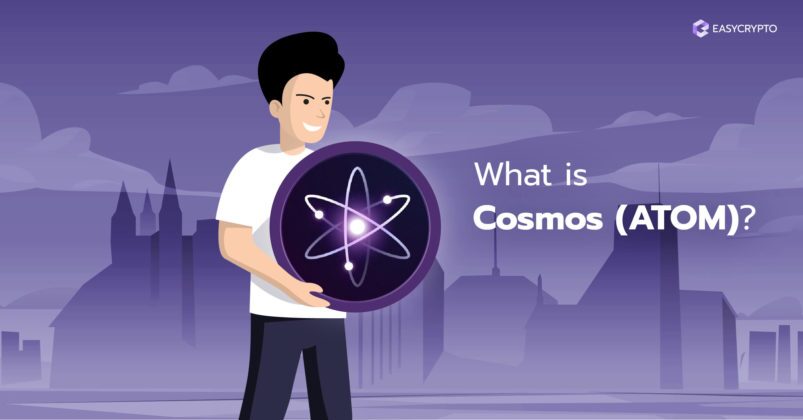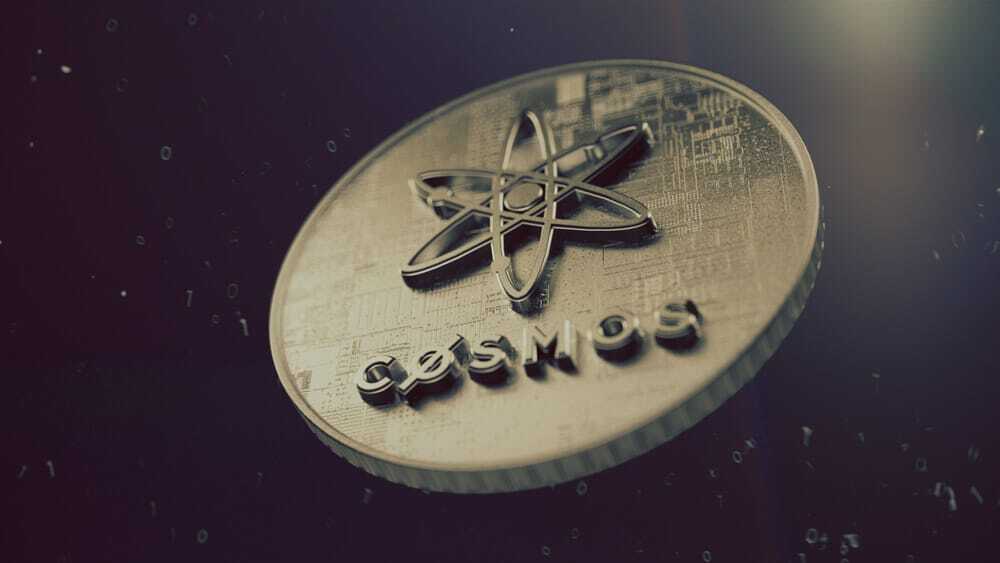What is Cosmos (ATOM)? How Does It Work?
As a fast, scalable and interoperable network, Cosmos can potentially accommodate more apps than Ethereum. What is Cosmos (ATOM)? Learn more.


When someone mentions the word “blockchain”, what comes to mind? Many would picture a blockchain as a network of computers supporting one platform, and this platform can accommodate all applications.
Although quite a few well-known blockchains work this way, such blockchain is often not interoperable with other blockchains. This often results in an unhealthy maximalist mindset: If one blockchain can do anything, why bother working with other blockchains?
The Cosmos Network (or simply, Cosmos) has a different approach. Rather than trying to become the one platform to accommodate all applications, it wants to become a network that connects highly specialised blockchains under one protocol.
Curious to know what Cosmos is and how ATOM works? Read until the end of this article.
What is Cosmos (ATOM)?
Cosmos is a decentralised network of parallel blockchains. At the center of the network is Cosmos Hub, a blockchain that records all activities on the network. It also acts as the intermediary in the Inter-Blockchain Communication (IBC) system.
Like any other blockchain, apps can be deployed on Cosmos Hub. However, one thing that makes Cosmos Hub special is that it is interoperable with any number of blockchains that use the common protocol, whether public or private.

All connected blockchains, including Cosmos Hub, work on top of a common protocol called the Tendermint Core. This protocol is named after the founding body, Project Tendermint, which is led by Cosmos creator Jae Kwon.
The Tendermint Core essentially provides the security and decentralisation power of hundreds of distributed computers. These computers, called validator nodes, are not owned by Project Tendermint but are privately owned by a diverse population of incentivised individuals.
At its most basic level, the Tendermint Core operates with an algorithm called the Byzantine Fault Tolerance, or BFT for short. This means that the entire network will be secure for as long as more than two-thirds of all validator nodes are not malicious.
The more validator nodes power the network, the less likelihood there is for a collusion of one-third of validator nodes looking to corrupt the network.
We will get into the details of how Cosmos works in an upcoming section.
What is ATOM, the cryptocurrency?
ATOM is the native cryptocurrency of the Cosmos Hub. It is used for paying transaction fees, securing the network through staking, and voting on any proposal to improve the network, as the platform itself is capable of self-governance.
Staking is an activity that is vital to the Tendermint Core protocol. Atom holders can deposit the cryptocurrency into the staking wallets of one or more validator nodes of their choice.
This activity is known as delegating. Alternatively, Atom holders can become a validator node if the technical requirements are met.

Staked Atoms are used to provide incentives to validators to behave in the interest of the network. The more Atoms a validator and delegators put together, the higher the potential reward will be given to them.
On the contrary, if a validator goes offline or becomes unavailable to work, a proportion of the collective funds will be slashed or removed, as a penalty.
If you’re still not sure how staking benefits the network at all, we will get into it in an upcoming section.
Learn the basics: What is Proof of Stake and How Does it Work?
How many Atoms are there in Cosmos?
New Atoms enter circulation via block rewards. Whenever a validator is chosen to process and record data into the Cosmos blockchain, the reward is distributed among the validator and the delegators.
An interesting part about Atom is that, at the time of writing, there is no known maximum supply limit for Atom; the cryptocurrency is inflationary.
According to this post on Cosmos Validator Economics by the Tendermint team, “The number of new atoms created per block is variable and depends on the percentage of the atom supply that is staked in the network.”
The inflation rate can vary between 7% and 20%. The target staked Atom is at least 66% of the total circulating supply. If the proportion of staked Atoms falls below that target, the protocol will gradually increase the annualised inflation rate up to a ceiling of 20%.
Overall, it would be more economical for all participants of the network to stake. Those who do not stake Atoms will see their wealth become diluted over time due to inflation, whereas staking will prevent this.
As staking is a central part of the Cosmos economy, it is highly encouraged by the Cosmos community to follow through with the easy-to-follow staking procedure.
Check the latest rates for Cosmos: Click here to view our live crypto rates.
How does staking work in Cosmos?
Cosmos operates with a Proof of Stake consensus protocol. Every few seconds, Cosmos picks a validator at semi-random to verify that no transactions are malicious, and it then bundles transaction data into a block to be added to the Cosmos Hub blockchain.
Validators with a much higher stake in Atoms have a much higher chance to be chosen as a block producer for a specific block time.

On other blockchains, becoming a validator is expensive, and so staking pools (a third party) were created to pool together funds so that all stakers in the pool collectively represent one validator, and that the block reward is shared proportionally.
On Cosmos, this process is simplified as Atom holders can delegate a validator easily and securely without trusting a third party. All validators are obligated to reveal the amount of staked Atoms, their minimum self-bonded amount, their commission rate, and other information such as how they operate as a validator.
Validators are somewhat like “fund managers”
The minimum self-bonded amount is the minimum amount of Atom that is being staked through a validator. If the amount of Atom staked falls below this minimum, the validator unbounds (the “staking pool” disperses), and funds are returned to the original holders.
Validators can choose this amount. If the amount is too high, there is a higher chance of an unbounding if there is reduced demand for this particular validator. If the amount is too low, and if the amount of staked Atoms is close to it, then the validator could struggle to profit.
The commission rate is the percentage of block reward that the validator will take. If you stake 1000 Atoms to a single validator with a 10% commission rate, then a 7% block reward will give you 63 Atoms (from 7% * 1000 Atoms * 90%).
Again, validators can choose the commission rate. A high commission rate may be due to a higher cost of operations to keep the validator node online at all times, although this reasoning does not apply in all cases.
It is up to the Atom holder to choose which validator node to delegate their stake of Atoms. In a sense, Atom holders are investors in the Cosmos economy.
Before participating in any staking activity, we highly recommend you to read this documentation on staking on Cosmos.
How does Cosmos work?
To understand how Cosmos works, we have to go back in time to see how legacy blockchains work. This is to see what makes Cosmos different, and what improvements it has made to blockchain technology.
How legacy blockchains work
We’ll start with Bitcoin. This ancestor of all blockchains is essentially a peer-to-peer payment application that is hosted in a decentralised network, which is secured through a consensus protocol.
Looking at Bitcoin’s architecture, the application, network, and consensus layers are all soldered together into a single component.

To change anything on any level, you need to copy Bitcoin’s source code and create your own version. This is known as hard forking, and there are plenty of Bitcoin hard forks still in existence today — not limited to Bitcoin Cash and Bitcoin SV, but also Litecoin, Dogecoin, and almost every other “first-generation” blockchains.
Then, Ethereum came along and introduced a programmable blockchain. On Ethereum, not only can you create a peer-to-peer payment application like on Bitcoin, but also more impressive things like marketplaces.
Looking at Ethereum’s architecture, the application layer is separate from the network and consensus layers.
However, Ethereum’s exclusive network is limited to 20 transactions per second, whereas hundreds of Ethereum applications all depend on it. To make matters worse, Ethereum still uses Bitcoin’s consensus protocol, which is energy-intensive and makes transactions expensive to make.
Learn more about Ethereum: Click here for our in-depth guide on the Ethereum network.
What Cosmos does differently
Cosmos was invented to separate the three layers to maximise transaction speed, reduce costs, and increase security. On Cosmos, applications don’t have to depend on one blockchain network. They could be built on another parallel blockchain, or even on multiple blockchains.
The network layer is also separate from the consensus layer. This means some blockchains can choose to operate privately, only taking advantage of the security that is offered by the consensus layer, without broadcasting any data across the Cosmos ecosystem.
Being interoperable with parallel blockchains introduces other benefits that will become apparent over time if Cosmos grows into a giant ecosystem like Ethereum.
On Cosmos, blockchains can be application-specific, rather than generic. This means one blockchain can offer a marketplace for lightning-speed auctions, like a stock market, for example. Another blockchain can offer a graphics-intensive gaming experience without compromising the performance of the other blockchain.
Specialisation is key to a growing economy
Cosmos has earned the title of the Internet of Blockchains. Rather than becoming Just Another Blockchain that is isolated and maximalist, Cosmos aims to become a network of networks.
Recognising the power of the network effect, Cosmos may one day become a major player in the field of interoperable blockchains, along with Polkadot and Polygon.
How to buy Cosmos (ATOM) in South Africa
With that said, anyone looking to diversify their crypto portfolio should really consider adding Cosmos (ATOM) to their list of coins.
What are your thoughts on Cosmos (ATOM)? Do you feel confident with Cosmos? If so, you can purchase some Atoms safely and securely with us at Easy Crypto.

Cosmos (ATOM) is just one of many altcoins that we offer at Easy Crypto South Africa. In fact, we have over 160+ altcoins ranging from NFT tokens, Metaverse, DeFi, and many more.
Start here: Follow our quick guide on how to buy crypto in South Africa.
Or, check our YouTube channel for an in-depth walkthrough!
As with any investment endeavors, be sure to do your due diligence and conduct your own research before making an investment decision.
Further reading: Explore our hub to learn all things crypto.
Share to
Stay curious and informed
Your info will be handled according to our Privacy Policy.
Make sure to follow our Twitter, Instagram, and YouTube channel to stay up-to-date with Easy Crypto!
Also, don’t forget to subscribe to our monthly newsletter to have the latest crypto insights, news, and updates delivered to our inbox.
Disclaimer: Information is current as at the date of publication. This is general information only and is not intended to be advice. Crypto is volatile, carries risk and the value can go up and down. Past performance is not an indicator of future returns. Please do your own research.
Last updated October 11, 2022





